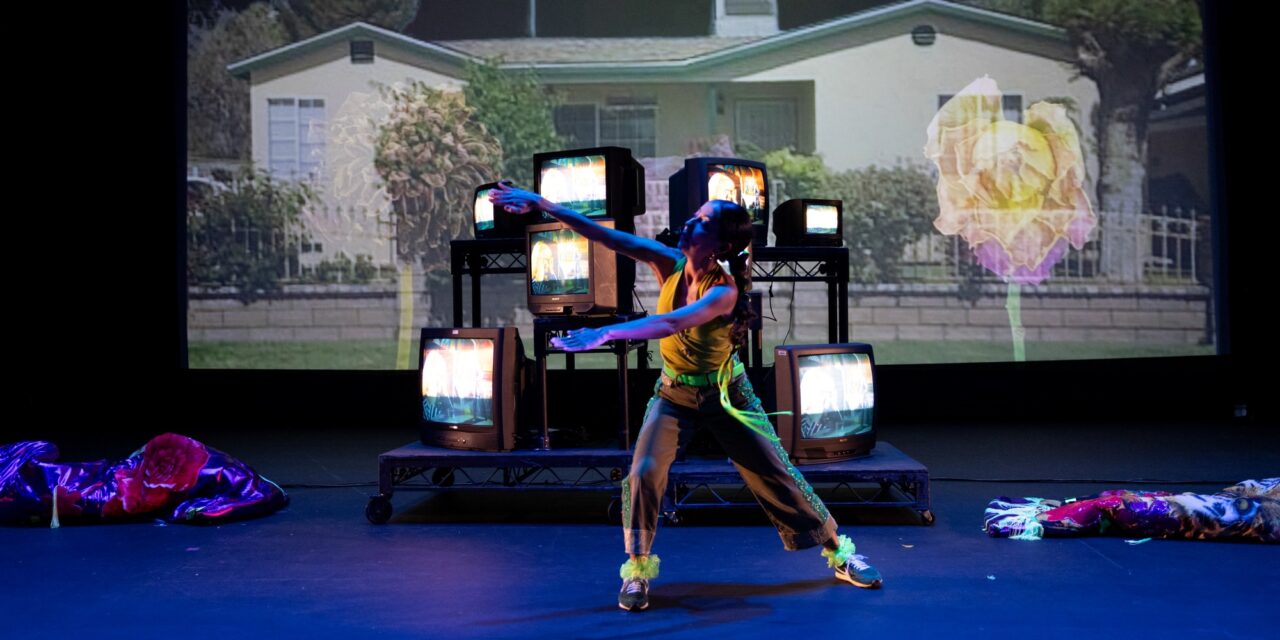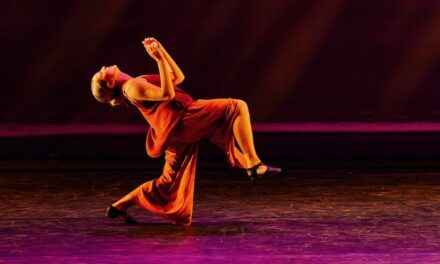The evening at REDCAT began with pre-performance announcements in Spanish. It felt like the announcements went on longer than usual and a feeling of anxiety and frustration set in. English announcements followed and a feeling of empathy washed over me as I thought about so many non-English speakers who face events similar to this every single day.
“History is not just facts and events.
History is also a pain in the heart and
we repeat history until we are able to
make another’s pain in the heart our own.”—Julius Lester
This single act set the tone for the entire evening. An evening during which the arts became transformative and thought provoking. This was an evening designed to build bridges of understanding and introduce the audience to “el desmadre” (the messiness) that characterizes the first-generation Mexican-American experience. The performance was presented in English and Spanish without surtitles.
Primera Generación Dance Collective (PGDC) is a collaborative group comprised of four artists based in Los Angeles and Riverside, California that utilizes text, satire, song, movement, and technology. According to program notes, “PGDC focuses on the visibilization of Mexican American corporeality, joy, and loss through movement-based exploration, process, and performance. The collective grounds their works in rasquache play and resourcefulness, generating work that speaks to their brown, working-class experiences.” The term rasquache, originally a slur, has been redefined to shine a light on the unique creativity of Chicano and Mexican working-class communities. This performance was certainly a celebration of Latin Pop culture, mainstream media depictions, historical icons, and much of what constitutes daily experiences of millennial Mexicans.

Primera Generación Dance Collective in “NOStalgia POP”- (L-R) Irvin Gonzalez, Alfonso Cervera, Rosa Rodriguez-Frazier, Patricia “Patty” Huerta, – Photo by Angel Origgi.
The program was a series of solo performances choreographed, written and performed by the company members. The opening performance, Gay Vaquerx Love Spell, was a mixed media presentation that seemed to revolve around the experiences of the queer Latin American creative. Tech seemed to lead the way from the phone conversation opening to the film that was integral to the piece. This was definitely a celebration of the gay cowboy!
Next came (amar)gura choreographed and performed by Patricia “Patty” Huerta. When one reviews the English translation of the title, amargura, the word “bitterness” immediately pops up. The “gura” portion of the title is perplexing but she appears to be an animae character and prominent virtual YouTuber. Looking closer one immediately sees a relationship between technology, the bank of televisions, and the story Patty is telling. Social dancing takes center stage with fun partnering, girls lifting and leading from time to time and men lifting men. This high energy piece, with green fringe swirling, had the audience laughing and moving along with the music. All the green conjured images of the magical world of Oz. Ms. Huerta was obviously influenced by the fast footwork of “House” and the dynamic foursome had their hips married to the Latin rhythms in the music. For a moment, my mind moved to Earl “Snakehips” Tucker the well-known Black American dancer and entertainer from the 1920’s who was considered the “Human Boa Constrictor”.
Como te Extraño (How much I miss you), performed by Alfonso Abraham Cervera exemplifies the bridge between queerness, Ballet Folklorico and Afro-Latine social dances. He introduces the audience to a multifaceted artivist who clearly has a love affair with Ballet Folklorico. The significance of the title becomes apparent during the post-performance talk following the program.

Primera Generación Dance Collective – Alfonso Abraham Cervera in “NOStalgia POP” – Photo by Angel Origgi.
Transitions between the previous solos were choppy and disjointed but this last transition into the last solo and large group piece worked perfectly. A total change of pace came with Rosa Rodriguez-Frazier and her La Gruquera POPular. Rosa in the kitchen cooking, cutting, pounding, rolling, making guacamole and beans and then breaking out into dancing that skillfully mixed Latin social dance, contemporary modern, and jazz was amazing. Her arms, hands, and hips communicated sheer unadulterated joy and an indescribable freedom and commitment to her movement and choreographic phrases. Although movement was somewhat repetitious it did not matter. Her joy in simply moving was contagious and she made the audience want more. During the post-performance talk Rosa told a poignant and touching story describing the relationship between cooking, dancing and her abuela. The three would forever be woven together in Rosa’s herstory. It was a beautiful moment that enabled the entire audience to step into Rosa’s world. The recorded voices and sound effects added to the overall piece but the artist did not need either. Her commitment transformed the space into a kitchen and then a dance hall with a pinata and all kinds of things fell to the floor as the pinata broke and beans dropped. Throughout the scene I am forced to admit that I became distracted with the question, “How will they continue to dance with all that stuff on the floor?” Suddenly everyone was cleaning and the dancing stopped. My question was answered but it was clear that this focus on cleaning had a much deeper meaning. The artists fully committed to this task of cleaning the space and the audience watched intently and began to sing. The transformative nature of this seemingly trivial act was profound. The transition was seamless. The artists were cleaning up “el desmadre” (the messiness) that characterizes the first-generation Mexican-American experience.
Once the mess was cleaned up stories continued to be told through movement, film, dialogue, and music. Certain phrases popped out loud and strong eliciting intense feelings of empathy, sadness, and joy as I listened and watched and attempted to take the entire performance in. “I had 3 Barbies. A white one, Pocahontas, and….” “You have to marry white to better the next generation.” “I’m working on myself.” “ 3 decades later I boldly address and confront memories as to why I see and understand the world the way I do.” “Queerness stuck to my body, my heart .” The tone changes again and stark images of Mexican icons, paintings, and historical images and events are projected and suddenly the images projected are the artists dancing. It is in this part of the program that the media works best. It was difficult to ascertain if the artists appearing to take selfies were in the film or on the stage. The images were so well synced with the actual artists on stage and integral to the choreography and story being told. A Spanish version of “Achy Breaky Heart” plays and the audience begins to clap. The artists’ excitement and commitment to this last pure dance section is so wonderful. Just as the program notes explain, “Four captivating dancers tell the story of how messy, fruitful, joyful, and painful the development of an ever-growing Latin Pop culture memory has been.”
The post-performance talk moderated by Dr. Jose Luis Reynoso was especially inciteful and provocative. The artists shared information about their choreographic process and clarified some of the life events and symbols behind the media, music, costumes, and movement. It was during this section that the audience learned that NOStalgia POP was developed over a shorter period of time then previous collaborations. Perhaps, as the collaboration is performed at different venues time will be available for editing and improving transitions to strengthen the presentation.
To learn more about Primera Generación Dance Collective, please visit their website.
For more information about REDCAT, please visit their website.
Written by Leah Bass-Baylis for LA Dance Chronicle.
Featured image: Primera Generación Dance Collective – Rosa Rodriguez-Frazier in NOStalgia POP – Photo by Angel Origgi.







